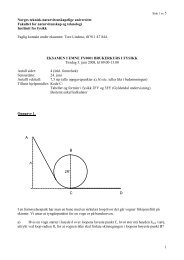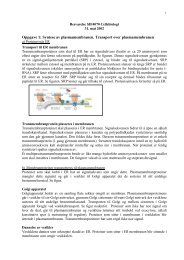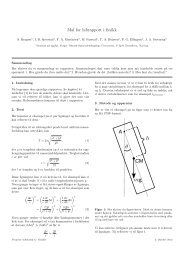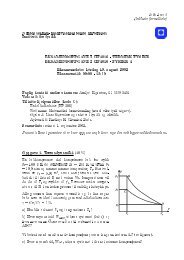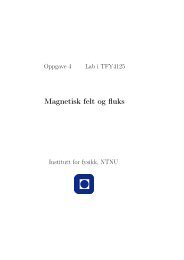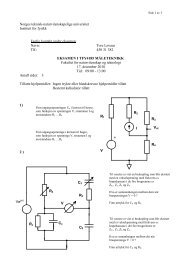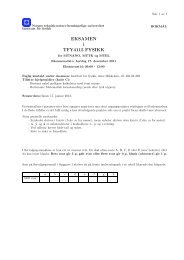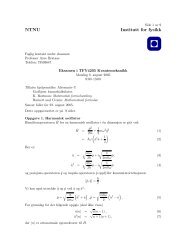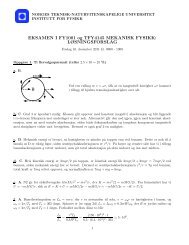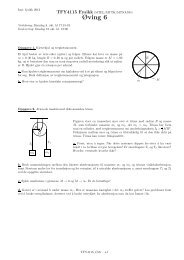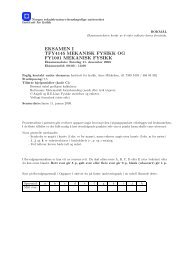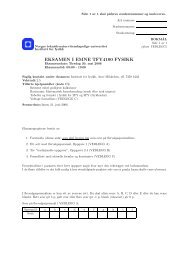DEPARTMENT OF PHYSICS, NTNU - intern - NTNU
DEPARTMENT OF PHYSICS, NTNU - intern - NTNU
DEPARTMENT OF PHYSICS, NTNU - intern - NTNU
Create successful ePaper yourself
Turn your PDF publications into a flip-book with our unique Google optimized e-Paper software.
superconductors. Our aim is to develop improved<br />
theoretical methods for describing transport and other<br />
phenomena in these systems, and to use these methods<br />
to improve our understanding of experiments.<br />
When a current passes through a ferromagnet, the<br />
resistance experienced by an electron depends on the<br />
direction of its spin. This leads to the giant magnetoresistance<br />
effect and related phenomena. However,<br />
there is also the inverse effect which can be envisaged<br />
as roughly due to Newton's third law: Action equals<br />
reaction. The spin- current induces a torque, a "spintorque",<br />
on the spins of the conduction electrons, which<br />
subsequently transmit this torque to the magnetization.<br />
This mechanism has attracted quite some interest<br />
recently, both because it is fundamentally interesting<br />
and because it has potential for use in magnetic random<br />
access memories, where the magnetization direction<br />
can be controlled by a current.<br />
We have demonstrated that there is also the reverse<br />
mechanism: Precessing ferromagnets inject a spincurrent<br />
into adjacent conductors. When the normal<br />
metal is a good sink this "pumping" of spins slows<br />
down the precession corresponding to an enhanced<br />
Gilbert damping in the Landau-Lifshitz equation<br />
describing the magnetization dynamics. This is<br />
important because it means that the magnetic response<br />
time of nanoscale magnets can be tuned by the<br />
surrounding media. In the opposite regime, when the<br />
spin-flip relaxation time in the normal metal is long,<br />
"spin-pumping" opens the way to create a pure spin<br />
source ("spin battery"). Consequently it is possible to<br />
create electronic circuits where only spins flow, but<br />
where there are no movement of the electronic charges.<br />
To this end we have formulated a theory of spin<br />
dependent transport of an electronic circuit involving<br />
ferromagnetic elements with non-collinear<br />
magnetizations. The magneto-electronic circuit theory<br />
is based on the conservation of spin and charge current<br />
and considerably simplifies the calculation of the<br />
transport properties of complicated ferromagnet-normal<br />
metal systems leading to a set of generalized Kirchoffs<br />
laws. Both novel DC and AC transport phenomena are<br />
found.<br />
The figure shows a magneto-electronic circuit with<br />
ferromagnetic and normal metal elements. Spin and<br />
charge currents depend on the relative direction of the<br />
magnetization.<br />
19<br />
2. Gauge theories for strongly correlated<br />
systems<br />
By A. Sudbø<br />
The main research theme in the group is currently, and<br />
has been for the last 2-3 years, the investigation of<br />
effective gauge theories of strongly correlated systems,<br />
and whether so-called confinement-deconfinement<br />
transitions, either in the form of second- or first order<br />
phase transitions, or even considerably more subtle<br />
topological phase-transitions, can present a viable route<br />
for destroying Landau Fermi-liquid theory in more than<br />
one spatial dimensions. This problem represents a<br />
major challenge in contemporary condensed matter<br />
physics. Our investigations into this problem builds on<br />
the experience we have gained over the last 6-7 years<br />
in large-scale Monte Carlo simulations of lattice gauge<br />
theories capable of describing topological phase<br />
transition in the context of the metal-superconductor<br />
transition or the metal-insulator transition.<br />
We have investigated the possibility of having a<br />
confinement deconfinement transition in the 2+1<br />
dimensional compact Abelian Higgs model when the<br />
matter field is in the fundamental representation. We<br />
have found a topological phase transition driven by the<br />
proliferation of ”magnetic” monopoles, which is in the<br />
universality class of the Kosterliz-Thouless phase<br />
transition well-known from two-dimensional physics,<br />
but here it occurs in 2+1 dimensions. The work has<br />
been published in Phys. Rev. Letters (Kleinert et al).<br />
We have also studied the possibility of spontaneously<br />
broken time-reversal symmetry in a strongly correlated<br />
fermion model system, published in another Phys. Rev.<br />
Letters (Marston et al). In a third work published in<br />
Phys. Rev. Letters ( Sudbø et al) we studied the<br />
possibility of charge fractionalization within the<br />
insulating phase of a strongly correlated system by<br />
considering the confinement-deconfinement transition<br />
in the 2+1-dimensional compact Abelian Higgs model<br />
for matter fields in higher represen-tations than the<br />
fundamental. Here we intro-duced a new method of<br />
extracting two critical exponents from the computation<br />
and finite-size scaling of one quantity, namely the third<br />
moment of the action. We demonstrated that this<br />
quantity yields superior quality scaling compared to the<br />
second moment of the action (essentially the specific<br />
heat of the system) for practically accessible system<br />
sizes. The remarkable property we find for this case is<br />
that the critical exponents are non-universal, and<br />
therefore that the phase-transition line represents a<br />
fixed-line rather than a fixed point. More detailed<br />
expositions of the above works are available on hepth/0209132<br />
and cond-mat/0301297.<br />
.



